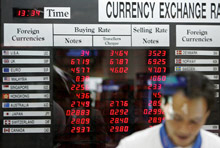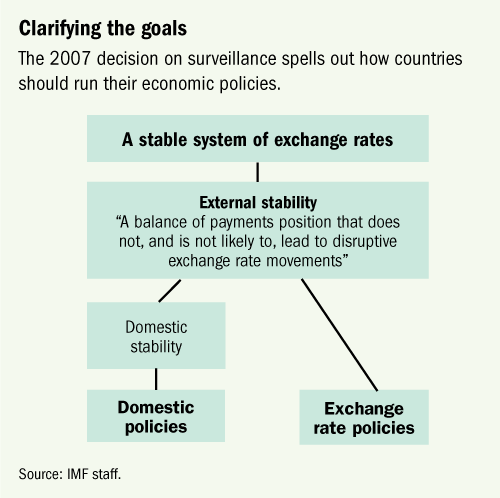
Typical street scene in Santa Ana, El Salvador. (Photo: iStock)
IMF Survey: IMF Clarifies How It Will Monitor Economic Policies
August 12, 2008
- IMF publishes guidance on how it will conduct economic surveillance
- Guidance clarifies how IMF will deal with concerns about exchange rates
- Procedures improve oversight by IMF Executive Board
The International Monetary Fund has published new procedures on how it will monitor member countries' economic policies, clarifying in particular how it will discuss with countries exchange rate issues and their impact on the global economy.

New procedures designed to reinforce effectiveness of surveillance at time of increasing strains in global economy (photo: Pornchai Kittiwongsakul/AFP)
EXCHANGE RATE SURVEILLANCE
The new procedures are designed to facilitate the implementation of a landmark decision adopted by the Executive Board last year. This decision strengthened the IMF's surveillance of the economic policies of its member countries by placing external stability at the heart of IMF surveillance, and promoting greater focus and candor in its operations (see Box 1).
These additional steps reinforce the effectiveness of surveillance at a time of increasing strains in the global economy, with high commodity prices, slowing world growth and continuing global imbalances.
Progress to date
The IMF has made good progress in implementing the 2007 decision. In particular, discussions between mission teams and member governments are now better focused on how members' economic policies impact the stability of their economies and of the economies of their partners, as mandated under Article IV of the IMF's Articles of Agreement. But progress has at times been hampered by technical difficulties in assessing exchange rate equilibria, and the frankness called for in some discussions of exchange rates has proved a sensitive matter.
Box 1: The 2007 Decision on Bilateral Surveillance
By crystallizing a shared vision of what bilateral surveillance is all about, the 2007 decision was intended to ensure that the policy dialogue between the IMF and its member countries is more focused, more candid, and overall more effective.
The decision provides a consistent conceptual framework to assess how members' economic policies impact the stability of their economies and that of the global monetary system. It also sets out four principles to guide members in the management of the exchange rates for their currencies. They are:
A. A member shall avoid manipulating exchange rates or the international monetary system in order to prevent effective balance of payments adjustment or to gain an unfair competitive advantage over other members.
B. A member should intervene in the exchange market if necessary to counter disorderly conditions, which may be characterized by, among other things, disruptive short-term movements in the exchange rate of its currency.
C. Members should take into account in their intervention policies the interests of other members, including those of the countries in whose currencies they intervene.
D. A member should avoid exchange rate policies that result in external instability.
The decision also lists seven indicators that would require thorough review by the IMF and might indicate the need for discussion with a member country. These include situations when the exchange rate is fundamentally misaligned—that is, when the underlying current account is not in equilibrium (which may be due to exchange rate policies but could also be caused by unsustainable domestic policies or market imperfections).
The IMF has now issued a paper that provides additional guidance to help overcome these difficulties. The new procedures and the technical clarifications will help ensure that countries in similar circumstances are treated in a similar fashion, and will also improve the dialogue with member countries and the Executive Board.
"I believe we all agree that exchange rates are at the heart of the Fund's mandate, and that in this connection the Fund must deliver good analysis and clear assessments, with the ultimate aim of helping to focus the minds of policymakers and encouraging appropriate policy responses," says Mark Allen, Director of the IMF's Policy Development and Review Department.
Better conceptual guidance
The paper clarifies a number of concepts relating to external stability (see chart), building on the staff's first year of experience with implementing the decision in different country cases.
So far, arriving at definitive findings about exchange rates (for instance, about a possible fundamental misalignment)—has proved challenging. In the past year, staff and management have had intensive discussions with several members for whom such findings are being considered. These discussions were very useful, in part because they focused attention on the appropriateness of exchange rate levels and regimes, topics that previously lacked such a high profile, and allowed staff and the authorities to carefully consider each other's views.
But because this dialogue has taken place outside the Executive Board, the IMF's Executive Directors and the member countries they represent have not had a chance to listen to the arguments of the country concerned or present their own points of view. According to Allen, "it should be the membership as a whole—through the Executive Board—that engages with the member in determining whether a problem is of such magnitude that the IMF needs to take a formal view on it, and in persuading the member of policy changes that may be needed."
A more intensive dialogue
In light of this experience, the paper lays out procedures to formalize a more intensive dialogue with member countries. In particular, the IMF's Managing Director is proposing the use of "ad hoc consultations" as a complement to regular Article IV consultations whenever the IMF has significant concerns that a member country may not be observing one or more of the four principles spelled out in the 2007 decision or that its exchange rate may be fundamentally misaligned—even if this misalignment does not stem from the active use of exchange rate policies (for instance, when the exchange rate is floating). An Executive Board decision will be required before initiating the ad hoc consultation (see Box 2).
Box 2: Initiating an ad hoc consultation
In a statement to the Executive Board, the IMF's Managing Director outlined the steps for initiating an ad hoc consultation:
Step 1: Following discussions with the member country, the IMF's Managing Director recommends to the Executive Board that it initiate an ad hoc consultation when he has significant concerns that a member may not be observing one or more of the four principles or its exchange rate may be fundamentally misaligned.
Step 2: The Board discusses the Managing Director's recommendation and makes a decision on whether to proceed with the ad hoc consultation.
Step 3: If given the green light, a consultation takes place and concludes with a discussion in the Executive Board. A consultation would normally be expected to be completed within about six months.
There are several advantages to this procedure:
• First, it will ensure that the voice of the international community is also heard (through the involvement of the Board), that the nature of the discussions is well understood, and that the process is conducted in an evenhanded fashion.
• Second, it will provide a clearer opportunity for member countries to frame and present their own views comprehensively and, if they deem it desirable, to adjust their policies.
• Third, it will help the IMF reach final conclusions on specific findings (whether a country's exchange rate is in fundamental misalignment or whether a member is in nonobservance of one or more of the four principles).
The initiation of an ad hoc consultation would in no way prejudge the final conclusions, nor would it mean that the underlying concerns over the exchange rate would only—or best—be resolved by a change in the nominal exchange rate. "The exchange rate must be seen against the background of the entire economic situation of a country and against the evolving global and regional backdrop; and misalignment can often be just a signal of a policy inconsistency that is best resolved without a change in the exchange rate" Allen said.

Comments on this article should be sent to imfsurvey@imf.org


